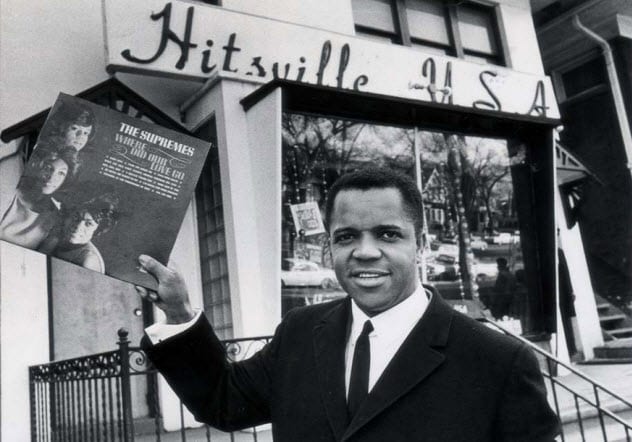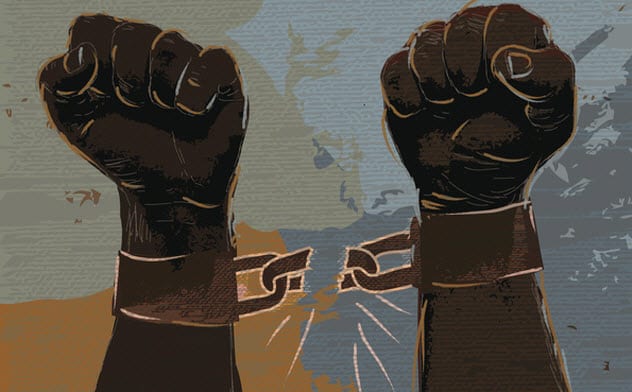 Animals
Animals  Animals
Animals  Weird Stuff
Weird Stuff 10 Weird Things People Used to Do at New Year’s
 Our World
Our World 10 Archaeological Discoveries of 2025 That Refined History
 Weird Stuff
Weird Stuff 10 Fascinating Facts You Might Not Know About Snow
 Miscellaneous
Miscellaneous Top 10 Things Crypto Was Supposed to Change & What Actually Did
 History
History 10 Huge Historical Events That Happened on Christmas Eve
 Music
Music 10 Surprising Origin Stories of Your Favorite Holiday Songs
 History
History 10 Less Than Jolly Events That Occurred on December 25
 Weird Stuff
Weird Stuff 10 Funny Ways That Researchers Overthink Christmas
 Politics
Politics 10 Political Scandals That Sent Crowds Into the Streets
 Animals
Animals 10 Species That Refused to Go Extinct
 Weird Stuff
Weird Stuff 10 Weird Things People Used to Do at New Year’s
 Our World
Our World 10 Archaeological Discoveries of 2025 That Refined History
Who's Behind Listverse?

Jamie Frater
Head Editor
Jamie founded Listverse due to an insatiable desire to share fascinating, obscure, and bizarre facts. He has been a guest speaker on numerous national radio and television stations and is a five time published author.
More About Us Weird Stuff
Weird Stuff 10 Fascinating Facts You Might Not Know About Snow
 Miscellaneous
Miscellaneous Top 10 Things Crypto Was Supposed to Change & What Actually Did
 History
History 10 Huge Historical Events That Happened on Christmas Eve
 Music
Music 10 Surprising Origin Stories of Your Favorite Holiday Songs
 History
History 10 Less Than Jolly Events That Occurred on December 25
 Weird Stuff
Weird Stuff 10 Funny Ways That Researchers Overthink Christmas
 Politics
Politics 10 Political Scandals That Sent Crowds Into the Streets
10 Historical Facts That Will Change How You Think About January
January is a month that generally gets a pretty bad rap. It has all the darkness and subzero temperatures of December minus the festive fun stuff. It is a month that most of us just want to get out of the way as soon as possible.
There is a lot more to January than work and dieting, though, as it is when some of the happiest events in our history took place. Here are 10 examples of human history changing for the better during January and—who knows—something equally great might happen before the end of this month.
10 The Invention Of The X-Ray Is Revealed

Given that we cannot all be Superman, it’s good that the X-ray was invented to allow a range of different medical problems to be detected. What a lot of people don’t realize, though, is that the announcement of this took place in January 1896.
The inventor was German physics professor Wilhelm Roentgen who was experimenting with passing an electrical discharge through a glass tube in late 1895 when he discovered that it gave off a fluorescent light that rendered aluminum, wood, and paper transparent.[1]
Roentgen tested his new discovery by taking an X-ray of his wife’s hand. She was seriously spooked to see her own skeleton as it made her imagine her death. He sent an article and photographs revealing his findings to other physicists and friends on January 1, 1896.
However, the public did not become aware of the invention until four days later when it made the front page of a newspaper in Austria called Die Presse, which also highlighted the potential that the X-ray had for use in treating various medical conditions. Roentgen received the Nobel Prize in Physics for his discovery.
9 The First US Flag Is Flown

Although we all associate the Stars and Stripes with the US, it was not the original American flag. That honor goes to the Grand Union. This flag contained the same red stripes on a white background as the one that followed it. But there were no stars, and the top left-hand corner featured a Union Jack.[2]
It served as the United States flag during the first year and a half of the War of Independence and was presented as the flag for the very first time on January 1, 1776. It can be argued that the Grand Union Flag was an important symbolic moment in the journey toward the US becoming an independent nation as the 13 stripes represented the 13 colonies that became the first to declare independence from the British.
This argument is further supported by the fact that it was the Grand Union Flag, not the more familiar Stars and Stripes, that was flown on the very first Independence Day, July 4, 1776. While it only served as the US flag until June 14, 1777, when the Stars and Stripes design was approved by Congress, we should not forget the place it has in the history of the country.
8 The First Photograph Of The Moon Is Taken

Most people with an interest in photography have taken a shot of the Moon, but until January 1839, no one had ever managed to capture an image of it. The man who changed all that was Louis Daguerre, an artist and photographer from France. He not only took the earliest-known picture of the Moon, but he also invented the first workable form of photography—the “daguerreotype.”[3]
This saw the images fixed on steel-plated copper using a development process involving mercury fumes and salt water. Daguerre captured an image of the Moon using this process on the recorded date of January 2, 1839.
While the shot of a crescent Moon may not have offered the kind of clarity and detail that we take for granted these days, it was crucial to the development of astronomy. Before photographing the Moon was possible, astronomers had been forced to make drawings. These sketches frequently missed key details and contained mistakes as the astronomers were trying to recall from memory what they had seen.
7 The Mona Lisa Is Shown In The US For The First Time

The Mona Lisa does not look like the sort of woman who would take a trip across the US, but that is exactly what she did in the early months of 1963. The painting by Leonardo da Vinci was displayed in America for the very first time on January 9, 1963, with its first port of call being the National Gallery of Art in Washington, DC. More than 500,000 people viewed it there before it left in early February 1963.
The story behind the iconic artwork coming to America began almost two years earlier when US President John F. Kennedy and his wife, Jackie, visited France. The First Lady struck up a friendship with Andre Malraux, the French cultural minister.
Malraux went on to pay a visit to the US during 1962. He attended the National Gallery of Art with Jackie, where she charmed him into agreeing to talk his government into letting the painting travel across the Atlantic. The French President Charles De Gaulle agreed to the idea because he saw it as a way of easing tensions between the two countries at the time.[4]
As a result, the fragile masterpiece made the trip by boat in a customized packing case designed to minimize vibrations and contact with surfaces. Following this initial spell in Washington, the Mona Lisa went on to be displayed at the Metropolitan Museum of Art in New York before its return to France.
6 Tamla Motown Is Launched

Tamla Motown is one of the greatest record labels in music history, and most of us recognize their songs. However, fewer people know precisely when the label was founded—an event that took place on January 12, 1959.
The man who created the label was Berry Gordy Jr., an ambitious young songwriter from Detroit. He had written hits for Jackie Wilson, among others, and the original name of the label was Tamla Records. Gordy Jr. used just $800 loaned to him by his family to launch the label, and he went on to set up a studio called Hitsville USA that same year.
Another curious, little-known fact is that he derived the name “Tamla” from Tammy, a series of teenage movies of the time starring Debbie Reynolds. “Motown” referred to the nickname of “Motor Town” that had been given to Detroit due to its car industry. It was originally set up as a separate label.
Becoming known as Tamla Motown, the songs produced at the studio owned by the company quickly became massive sellers in the US. “Shop Around” by The Miracles was the first big hit in 1960, while The Marvelettes’ “Please Mr. Postman” brought the first No. 1 the next year.[5]
Alongside the chart hits, it should be remembered that Motown was also a successful company owned and run entirely by black people at a time of serious racial inequality.
5 The First Super Bowl Takes Place

Some people prefer sports to music, and January has a significant historical event to suit them as well: the first Super Bowl. On January 15, 1967, the teams competing in this debut clash of the AFL and NFL were the Kansas City Chiefs and the Green Bay Packers. The venue for the match was the Memorial Coliseum in Los Angeles.
It was a lot different from the spectacle that we know and love now. Back then, the stadium contained empty seats and television coverage was blocked for fans within a 120-kilometer (75 mi) radius outside of LA. This led to curious scams, such as a man who advertised plans for building a super-powerful TV antenna that he would send to anyone for $2.
It was not even officially called the Super Bowl that first year. Instead, it was referred to as the AFL-NFL World Championship. Meanwhile, the less than super entertainment was a university marching band, a trumpeter, and for some reason, a bunch of men wearing jetpacks.[6]
The game itself saw the Packers overwhelm the Chiefs by 35–10, with three second-half touchdowns. It seems unlikely that anyone could have predicted on that day that the Super Bowl would become a major event on the sports calendar.
4 Martin Luther King Jr. Day Becomes A Federal Holiday
Most of us regard Martin Luther King Jr. (MLK) as a seminal figure in US history. But the campaign to have his contribution to civil rights recognized by making his birthday a federal holiday was a long one.
The minister and activist was born on January 15, 1929, and the idea was always for the day celebrating him to be as close to his birthday as possible. The first legislation proposing it came from Michigan Congressman John Conyers Jr. during the 93rd Congress in 1973–74.
However, the first instance of the day actually being marked happened in January 1969 when the newly founded King Memorial Center sponsored it. But it was not recognized at the government level. The idea continued to be mooted by Conyers Jr. and Coretta Scott King, the widow of MLK, throughout the 1970s.
Eventually, it won support from President Jimmy Carter on January 14, 1979. His successor, Ronald Reagan, made it an official federal holiday. The first official Martin Luther King Jr. Day was celebrated on January 20, 1986, with everything from a freedom train to marches, concerts, and vigils.
The day was still only acknowledged by 27 states, with Arizona’s refusal to do so costing them the 1993 Super Bowl. It took until January 18, 1993, for all 50 US states to officially observe the day.[7]
3 The First Canned Beer Is Produced

While it is not an event of the same significance as Martin Luther King Jr. Day, we really would not want to live in a world without cold canned beer. From January 24, 1935, onward, we no longer had to.
That was when the Gottfried Krueger Brewing Company and the American Can Company teamed up to put cans of Krueger’s Cream Ale and Krueger’s Finest Beer in the stores of Richmond, Virginia, for the first time. Cans had long been an established way of containing food, and the concept of supplying beer in this way had been kicking around since 1909.
However, it was not until Prohibition was repealed in 1933 that the American Can Company hit on the idea of a can featuring a coating of enamel and brewer’s pitch. It was designed to stop the beer from reacting against the metal, which affected the taste and color. Also, a pressurized can controlled the internal pressures caused by pasteurization.
The first brewery willing to take a chance on the cans was Krueger. But even when the results met with public approval ratings of over 90 percent, it didn’t persuade other breweries.
It was only when rivals like Anheuser-Busch found their market shares falling as a result of the new canned beer that they changed their minds. By the time 1935 ended, more than 200 million canned beers had been sold in US stores.[8]
2 Apple Announces The iPad

January has also brought good news for tech geeks in the past. On January 27, 2010, Apple announced a major technology breakthrough by launching its iPad tablet. The iPad was the first tablet to really catch on with the general public even though many critics argued at the time that we would reject it as we had all previous tablets.
A big reason for the iPad’s success was that Apple CEO Steve Jobs realized that we mostly use tech devices for everyday activities like checking email, browsing social media, listening to music, and watching films. He presented the iPad as the perfect device for these things. The screen was much bigger than that of a mobile phone, but the overall size made it more portable and less bulky than a laptop.[9]
In the years since then, Apple has produced five more iPad generations as well as additional models like the iPad Pro and Mini. Over 360 million had been sold by spring 2017.
1 The 13th Amendment Is Passed

In January 1865, one of the most important pieces of legislation in US history was finally passed: the 13th Amendment that abolished slavery. On January 31, the House of Representatives passed this amendment.
It had already made its way through the Senate the previous year. But it had failed to get through the lower chamber of Congress after Democrats resisted it on the grounds that it was an infringement on the rights of individual states.
When the 1864 election secured majorities in both chambers for the Republican Party, the legislation got through and became law. President Abraham Lincoln played a direct part in ensuring this success on the second attempt.
He pressured Unionists to accept the amendment and persuaded members of the House with offers of top jobs in his administration. Lincoln brought them directly to his office in the White House so that he could talk to them face-to-face about it.[10]
The 13th Amendment to the Constitution made “involuntary servitude” of any kind illegal in the US except for those individuals convicted of a crime and sentenced to prison. The bill passed by 119–56.
I am a freelance writer who also makes short films as part of Wardlaw Films.
Read more historical facts you probably don’t know on 15 Historical Facts You Don’t Know and Yet Another 20 Fascinating Historical Facts.








